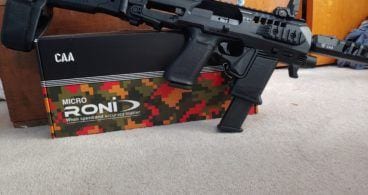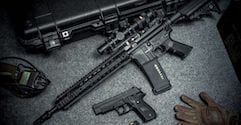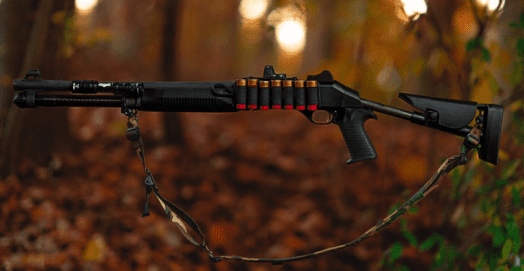The Gen 5 GLOCK 17 – A Reliable Gun That You Can Count On

Gen 5 GLOCK 17
Stop the presses, Glock finally broke the mold with the Gen 5 GLOCK 17! Just kidding, you know they wouldn’t do such a thing. It has been a full 9 years since the Gen4 Glock was introduced onto the scene. With the MHS trials over, and an FBI contract secured recently, the public sector is finally getting to know what all the fuss is about. The Gen 5 GLOCKS are out and about in stores and you can put your grimy hands on one now, but what exactly are they doing differently than the Gen 4 variants and why are they worth taking a look at? This is especially important because Glock still has brand new Gen 4 guns in stores, sold alongside the Gen 5s! We will go through these below in a list, in no particular order.

Contents
1. Finger Grooves
A severely polarizing aspect of the Gen 3 and Gen4 Glocks was the finger grooves. Love them or hate them, there was almost no in-between. Many folks who opted to do a stippling job would have them removed among other things done to the gun. The Gen5 Glocks have done away with these grooves, and while this is again controversial, it may be a good thing for you folks that get the frames customized, as it will be slightly less work for the stippling service. The texture of the frame is similar to all other generations, and the material is identical in feeling, if not the exact same material, which is most likely a blend of PA6.6 and a few other proprietary aspects of Glock’s doing. This is of course reinforced with either glass beads, glass fibers, or carbon fiber for strength. This type of plastic is extremely tough, and if past Glocks are any indication, this should hold up well over many years of use.
2. Flared Mag Well

One aspect of Glocks that has always bothered the author, as well as many other Glock owners for sure, is the magazine well of the Glock. Plenty of other pistol manufacturers have done their part to make the magazine wells of their pistols funnel-shaped to assist in guiding the magazine. Glock has made it very easy in the past to put an aftermarket mag well on the gun, but this is the first time that they have incorporated one into the grip frame. Why did this take so long? Nobody knows, but one thing is for sure, it’s a welcome addition to the handgun, and definitely makes magazine changes much more smooth.
3. AmeriGlo Sights
Glocks have been coming from the factory, ever since their inception in 1984, with sights. You probably already knew that, but you might not have considered that they have been shipping with PLASTIC sights for many, many years. This to some is basically heresy. However now Glock is shipping the Gen5 guns with metal AmeriGlo night sights, which have tritium for 12 years of bright glowing. In case you don’t know anything about Tritium sights. They basically have a small glass vial of Tritium gas in the sights. This vial of gas is slightly radioactive and happens to glow brightly (for its size) for around 12 years from the time the sights are made. They still glow after this time, but not nearly as bright. These have major advantages to other types of night sights, since they don’t have to be charged by light, glow continuously, and can be augmented with standard glow in the dark materials such as Strontium Europium, currently the brightest “glow in the dark” material.
These AmeriGlo sights are wonderful additions to the gun, and the fact that the gun is ready to go with them out of the box, is nothing short of fantastic. Gone are the days of buying a Glock, and immediately having to press the plastic sights out in the gun store for $25 just to get to a metal sight that the gun should have come with.
4. Ambi Slide Stop
Glocks are not known for being ambidextrous, however, they are not exactly right hand only as well. The magazine release has been switchable since the Gen4 guns, and there are no safeties on the gun to speak of, so usually, this release being switched makes the gun perfect for a left-handed person. However, the Glock has had a one-sided slide release since the Gen 1 guns, and there has not been a great solution to this yet. The Gen 5 guns deal with this problem with factory parts, so once you switch the magazine release, this gun is ready to be fully manipulated by left-handed folks.
5. Glock Marksmen Barrel (GMB)
The GLOCK Marksman barrel (GMB) features enhanced barrel rifling based on the proven polygonal barrel design which delivers improved accuracy. Glock has traditionally relied on Polygonal rifling in their handguns. Some folks believe that this makes them unable to use soft lead bullets that reloaders commonly use. Match grade barrels using traditional rifling were offered by many aftermarket parts manufacturers, and some believe that this was the only way to achieve consistent accuracy with Glocks. However, Glock has now instituted some traditional rifling in their barrels and is marketing this as the Glock Marksman Barrel. This is a welcome addition as well; with the addition of red dots to most handgun systems, handgun accuracy is rapidly becoming an issue that needs to be dealt with at a factory level, since a <10MOA dot will allow shooters to see that their gun is not consistent far easier than the large factory iron sights.
6. nDLC Coating

nDLC huh? What does that mean? Don’t worry we gotcha. Glock has changed the coatings that they use on their slides and barrels. In older generations, the process used is called Tennifer, or Melonite. These are trade names for ferritic nitrocarburization, which basically builds a very hard, corrosion-proof layer on top of the steel using a molten salt bath at extremely high temperatures. The Gen5 is using a process called DLC (Diamond Like Coating), these coatings are diamond-like thin-film coatings applied either through a physical or chemical vapor deposition process. These coatings are often referred to as DLC coatings, but they can be customized in significant ways to maximize durability, reduce friction, or improve appearance. Common applications include machine tooling, engine components, aviation, cutting tools, medical devices, watches, and of course firearm parts.
What does all this mean to you, the consumer? Superslick, super durable and attractive parts that should provide extra life to your Glock over the many years of ownership, even in rough environments. This process is the highest tech coating available, and it is definitely an improvement over previous generations of Glocks.
7. Improved Trigger
Walk into the gun store and assemble a row of every current polymer pistol. Glock (Gen4), S&W, HK, CZ, SIG, etc. etc. Walk down the line and try every stock trigger. I will bet that the Glock stays near the bottom of the pack as far as trigger feel and reset. For many years this was the story and most folks either dealt with the bad trigger or changed to an aftermarket trigger kit, which was fast and easy. Now do the same thing with a Gen 5 Glock, and it will most likely be near the top of the pile, if not at the very top. Glock listened to the customers and provided a crisp, clean trigger pull right out of the box. Of course, if you aren’t satisfied with this, you can upgrade to an aftermarket kit, but finally, you can take the gun directly to the range and have a higher-end pistol experience to accompany the Glock’s premium pricing.
8. Front Serrations
Glock has been dragging their feet on front slide serrations for a long time now. While there are pluses and minuses regarding front serrations being used to “press check” a pistol, some people just like the look of front serrations. Since the introduction of front serrations on the guns however, this meant damaging the finish of the gun and having some other finish applied. This added cost took extra time, and honestly should have been included by Glock many years ago.
Now, the Glock 17 is the “duty” or “full size” frame handgun, chambered in 9x19mm, which is currently America’s best-selling handgun caliber and has been for many years. Here are a few stats of the G17:
Magazine Capacity-17 standard (19, 24, 31, 33 rounds available)
Barrel Length- 4.49in (114mm)
Weight (without magazine)-22.22oz (630g)
Weight (with loaded magazine)-33.33oz (945g)
Overall Dimensions-
- Length-7.95in (202mm)
- Width- 1.00in (25.5mm)
- Height- 5.47in (139mm) (includes magazine)
Sight Radius-6.42in (163mm)

This is not Glock’s smallest handgun for sure, but it is also not the largest. Many people regard the G17 model as slightly too large to comfortably conceal carry (the Glock 19 was pretty much the gold standard until the SIG P365 came around) but is a great gun at the range and handle recoils well for even nubile shooters. Holster options, from IWB (inside the waistband) to OWB (outside the waistband) are available and plentiful all over the country. The Glock 17 was actually the first Glock model introduced and has remained a mainstay at the company ever since 1984. A quick note, the number of Glock usually has no bearing on caliber, capacity, or size. The G17 happens to hold 17 rounds, but for instance, the Glock 40 is actually a 10mm extended barrel Glock that only holds 15 rounds. The Gen 5 Glock 17 is not a “modular” handgun in current parlance, as the only thing that you can alter is the grip circumference with some include back straps. Glock tried to claim that it was “modular” during the MHS trails, but it became quickly clear that the competition had outdone them. The backstraps included in the box can be used to slightly customize the grip size of the gun, and if you have particularly large hands, you might feel the need to use these.
Speaking of customization, most, if not all Gen4 internals (trigger systems, triggers, magazine releases) are not direct fits, and you should call the manufacturer of your parts to check if they DO fit, and if they do, make sure they work reliably before trusting your modifications on a duty or self-defense weapon. The front rail has not changed, but one should be aware that when using a Glock rail for a laser, light or other tool, the Glock rail is not directly Picatinny compatible; Streamlight includes a special insert for their TLR lights to facilitate zero retention on lasers. Glock does offer MOS options, these are specially made to accommodate plates for mounting of pistol optics on the slide of the Glock. If you choose to purchase a non-MOS Glock, make sure that when cutting the slide for an optic, you check with your machinist or customizer that they have tried this cut on a Gen 5 Glock, as there could be some internal slide changes between generations that might affect the cut.
Parting Shots…
As far as real-world differences between the Gen5 and Gen4 Glock 17, I believe that a casual shooter will almost notice no difference at all. There are a few large differences like the ambidextrous slide release, and the lack of finger grooves, but all in all, the gun is largely the same. The DLC coatings are a really nice addition, and the simplified detail strip is nice, but all in all, it’s just a Glock 17 with a few tweaks here and there. If that sounds like your cup of tea, be my guest, but if you already have a Gen 4 that you are invested in, I don’t think that the changes fully justify buying a new gun. However, if you are buying your first Glock, the Gen 5 definitely has some advantages over a Gen 1, 2, 3 or 4. The bottom line, the Glock 17 Gen 5 is a fine gun, although nothing particularly revolutionary.













